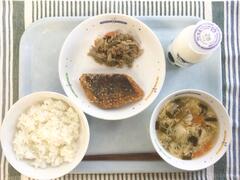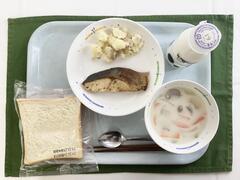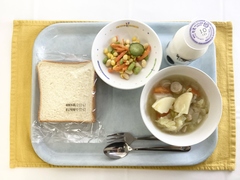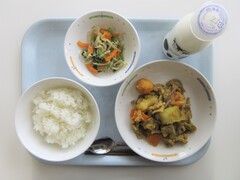Last updated: March 19, 2024
Osuwai (daikon radish with sweet and sour sauce)
The local school lunch in March is Toyama Prefecture. Osuwai is a local dish of Toyama Prefecture that consists of vegetables such as daikon radish and carrots mixed with sweet vinegar.It is said that the name osuwai came to be called osuwai, which is a corruption of the word ``osu-ae.'' It is said to be a standard dish that is widely eaten from everyday dining tables to celebrations. For the school lunch, we added carrots, daikon radish, and cucumbers and tossed them with sweet and sour vinegar.

School lunch on March 18th
Graduation Celebration School Lunch Sekihan, which is steamed sticky rice mixed with red beans and cowpeas, is often eaten during celebrations. This is because the color red has long been believed to have the power to drive away bad things.
In addition to sekihan, we also prepared flower-shaped tofu hamburgers and celebratory desserts. All the staff at the kitchen pray from the bottom of our hearts that all of our graduates will continue to eat happily every day and stay healthy.

School lunch on March 13th
Sopa de Ajo February's world cuisine is Spain. Spain is located in southern Europe and is a country where you can find an abundance of delicious ingredients, such as seafood from the Mediterranean and mountains from the Iberian Peninsula.
Garlic is also one of Spain's famous ingredients. Today's school lunch, ``Sopa de Ajo,'' is a soup that is popular throughout Spain as a local dish, with ``Sopa'' meaning soup and ``Ajo'' meaning garlic. I sautéed garlic in olive oil to bring out its aroma, and then added eggs as a finishing touch.
School lunch on February 27th
Kenojiru Today's school lunch is Kenojiru, which is known as a typical local dish from the Tsugaru region of Aomori Prefecture.
Kenojiru is said to have originally become ``Kenojiru'' when the name ``Kayanojiru'' was corrupted. A nutritious soup made with finely chopped vegetables and wild plants, simmered, and seasoned with miso and soy sauce. It has also been said to be a Buddhist vegetarian meal eaten during the New Year holidays to pray for good health.
Ingredients, methods, and seasonings vary depending on the region and household. Today's mushroom soup has a gentle flavor with mirin, salt, and soy sauce.
School lunch on February 22nd
Ashitaba Bread Ashitaba is a green vegetable harvested on Hachijojima Island in Tokyo and its surrounding islands, and is characterized by a slightly bittersweet flavor. Ashitaba bread is kneaded with powdered Ashitaba. Today, to celebrate Tokyo Verdy's return to J1, we made a twisted ring shape that resembles the shape of a crown.
Additionally, in the school lunch survey conducted last year, there were many requests for gratin. In the kitchen, it is difficult to make the ingredients and then separate them into individual portions and bake them in the oven, so we have created a ``no-bake gratin'' made in a large pot. How do you like the taste?
School lunch on February 15th
Tokyo Verdy Cheer Lunch Do you know about "J League"? Japan's professional soccer league is called the "J League," after the initial "J" in the word "JAPAN." Depending on the ranking of the league match, it is divided into J1, J2, J3, etc. from the top.
Today, Inagi City celebrated the return of their hometown team, Tokyo Verdy, to the J1 League by making Tokyo Verdy support jelly using green Muscat jelly, the club's color. The white jelly included is pear flavored. Let's eat school lunch and support Tokyo Verdy.
School lunch on February 13th
mixed rice
January's world cuisine is Korean. South Korea is located in the southern part of the Korean Peninsula in East Asia, and is a country close to Japan.
Bibimbap is a Korean dish, where ``bibim'' means ``mix'' and ``ba'' means ``rice.'' Seasoned meat or vegetable namul is placed on top of the rice, mixed well with seasonings such as chili peppers, and then eaten.
For school lunches, vegetables and meat were stir-fried and seasoned with seasonings such as red bean paste and gochujang. The spiciness is kept to a minimum so that it is easy to eat.
School lunch on January 31st
whale ketchup sauce
January's local school lunch is from Wakayama Prefecture. Taiji Town in Wakayama Prefecture is known as the place where full-scale whaling began in Japan.
Whales are a rare ingredient these days, but in the past people used to eat whale meat as a valuable source of protein because it was cheaper than pork or chicken. It is an ingredient often used in school lunches.
Today's whale was seasoned with ginger and garlic, then coated with starch, deep-fried, and topped with homemade ketchup sauce.
School lunch on January 29th
January 24th to 30th is National School Lunch Week It is said that it started when the service was provided for free. After that, school lunches began to be provided in various places, but they were suspended due to war and other factors. After the war, ``National School Lunch Week'' was established from January 24th to 30th to commemorate the resumption of school lunches using relief supplies.
School Lunch Week is a week for everyone to think about the significance and role of school lunches. Let's take this as a good opportunity to learn about the school lunches that we usually eat casually.
Today's school lunch is ``Yanagawa-don'', which is an arrangement of Yanagawa-nabe, which was born in the Edo period.
★From today until the 30th, the “Inagi City School Lunch Exhibition” will be held at the Shiroyama Experience Learning Center! There are many exhibits where you can learn about school lunches in Inagi City, so please feel free to come and visit us♪
School lunch on January 24th
strained soup
The local school lunch in December is Gunma Prefecture.
Gunma Prefecture is located in the northwestern part of the Kanto region and is home to rich nature and many hot springs.
Koshine soup is a local dish of Gunma prefecture. This soup is made with Gunma prefecture's special products, konnyaku, shiitake mushrooms, and green onions, and is named ``koshine soup'' by taking the first letter of each ingredient's name. It is a popular edible miso soup made with plenty of vegetables.
Warm your body from the core by eating miso soup that is full of nutrients.
Lunch on December 20th
Fresh rice from Nozawa Onsen Village cooked in the kitchen <br id="3"/>For school lunches, we provide each school with rice cooked using the rice cooking equipment in the No. 1 kitchen about once a month.
This month, we will be serving freshly harvested rice harvested in Nozawa Onsen Village, Nagano Prefecture, a friendship city of Inagi City, cooked in the rice cooking equipment of the Daiichi Kitchen. (Please check the menu table for each school's allocation date.)
Nozawa Onsen Village in Nagano Prefecture grows delicious rice thanks to the abundant snowmelt water that flows into Nozawa Onsen Village from the nearby mountains.
Chew the rice well and feel the sweetness of the rice.

School lunch on December 11th
Pot-au-feu
December's world cuisine is French.
France is a country located in Western Europe, officially known as the French Republic. Agriculture is very popular and many crops are grown.
Also, like Japanese cuisine, French cuisine is also registered as a UNESCO Intangible Cultural Heritage.
Pot-au-feu is a French home-cooked dish. In French, "pot" means pot or pot, and "feu" means fire, so pot-au-feu means "pot on fire."
It is a stew dish in which meat and vegetables are simmered for a long time.
School lunch on December 8th
Japanese food day
November 24th is known as ``Japanese Food Day'' due to a play on the words ``ii (11), nihon (2), and shoku (4)''.
Washoku, Japan's traditional food culture, is characterized by its emphasis on the natural flavors of food and its emphasis on seasonality.
Today, I made a Japanese food menu using root vegetables that are delicious in autumn, ``dashi'' made from bonito flakes, and typical Japanese seasonings such as soy sauce and miso.

School lunch on November 24th
Sienikeit
The world cuisine of November is Finland.
Finland is a cold country, so there are many dishes that warm you up, such as hot pot dishes and oven dishes.
This time, I chose Sienikeit (cream of mushroom soup) from among the many dishes.
In Finland, mushrooms are mainly used. Stir-fry the ingredients, sprinkle with flour, add water, consommé, milk, and fresh cream, and bring to a simmer.
Sienikeit, which is simmered until melty, warms the body, making it recommended during the cold winter months.

School lunch on November 15th
Potatoes from Ozora Town <br id="3"/>Oozora Town and Inagi City, Hokkaido are sister cities, and they exchange each other's specialty vegetables and fruits.
Pears are sent from Inagi City, and freshly dug potatoes are delivered from Ozora Town.
Ozora Town has a thriving agricultural industry, growing wheat, potatoes, sugar beets, which are the raw material for sugar, beans, vegetables, and rice.
Today's simmered winter vegetable soup was made using potatoes that arrived from Ozora Town.

School lunch on November 7th
gapao rice
October's world cuisine is Thai.
Thailand is located in Southeast Asia and is officially called the Kingdom of Thailand.
Gapao rice is a classic Thai dish made with stir-fried ingredients such as ground chicken, onions, and green peppers and served over rice.
In Thailand, they use nam pla, a seasoning similar to soy sauce made from fish, which gives it a unique aroma, but school lunches also include oyster sauce and soy sauce to make it easier to eat.
School lunch on October 30th
Asuka soup made with soy milk <br id="3"/>Asuka soup is a miso soup made with milk, chicken, and seasonal vegetables, and is a traditional dish from Nara Prefecture.
Milk and chicken dishes were introduced from China's former dynasty, the Tang Dynasty, during the Asuka period, and are said to have been eaten among the nobility.
For the Asuka soup for today's school lunch, I used soy milk instead of milk.
The soy milk and the miso seasoning are both made from soybeans, so they go well together and give the dish a mellow taste.
School lunch on October 18th
Tokyo Verdy collaboration school lunch <br id="3"/>Tokyo Verdy is a professional soccer club based in Inagi City.
Verdy means "green" in Portuguese, and the club's color is green.
For school lunch, we made keema curry using spinach, a typical green vegetable.
In addition, the blueberry jelly dessert uses blueberries grown in Inagi City.
The package is an original package that is a collaboration between Inagi City's official character "Nashinosuke Inagi" and Tokyo Verdy mascot character "Rivern".
Let's eat school lunch and support Tokyo Verdy's success together.
School lunch on October 10th
Sanzokuyaki (fried chicken from rice flour)
Sanzoku-yaki is a local dish from Nagano Prefecture, where chicken thighs are marinated in soy sauce, sprinkled with potato starch, and fried in oil.
The name is said to be a play on the word "chicken" and "fry," since bandits "take" things from people.
Although it looks similar to karaage or tatsutaage, Sanzokuyaki is characterized by the fact that it is marinated in sauce for a long time to give it a strong flavor, and that the pieces of meat are very large and voluminous.
It has a strong garlic flavor and goes well with white rice.
School lunch on September 11th
Fritz potatoes
September's world cuisine is Belgium.
Belgium is located in the west of Europe and is often referred to as the heart of Europe due to its convenient transportation to other countries and the location of the EU headquarters.
In Belgium, french fries are called fritzpotatoes, which means fried potatoes.
Not only can it be eaten as a side dish, but it is also famous as a light snack that can be enjoyed casually around town.
Apparently, potatoes are typically eaten with sauce such as mayonnaise, ketchup, or tartar sauce.
Today, I made salty fried potatoes.
School lunch on September 7th
Fasolada (white bean soup)
July's world cuisine is Greek.
Greece is a country in southeastern Europe, where civilization has flourished for over 4,000 years, and it is also famous as the birthplace of the Olympic Games.
Greek cuisine, along with cuisines from Spain, Italy, and Morocco, is called the ``Mediterranean diet,'' and like Japanese cuisine, it is registered as a UNESCO Intangible Cultural Heritage.
For today's school lunch, we made a soup called ``Fasolada'', which is a classic home-cooked dish in Greece, made with slowly simmered white beans and vegetables.
School lunch on July 11th
Mozuku soup
The local school lunch for July is Okinawa Prefecture.
Mozuku is a type of seaweed, like wakame and hijiki, and has a long, thin, branched thread-like shape similar to somen noodles.
The surface is slimy and has a strong adhesiveness.
Mozuku is often eaten mixed with vinegar to make "mozuku vinegar," but in Okinawa Prefecture, which produces the most of it in Japan, it is also sometimes eaten as tempura.
For school lunch, we added mozuku seaweed to a soup made from chicken bones.
Enjoy the smooth texture and crunchy feel of mozuku seaweed.
July 4th Lunch
Chili pepper soup
June's local school lunch is from Aichi Prefecture.
Aichi Prefecture is a prefecture located in the central part of the Japanese archipelago.
Although there are many automobile-related companies and the city has a strong image of an industrial city, it also has a thriving agricultural industry.
Togan boasts the second largest production volume in Japan after Okinawa Prefecture.
For this reason, it is said that chili pepper dishes are familiar and often eaten.
Chili pepper soup is a local dish from Aichi Prefecture, and is a thick soup made by boiling chili peppers with chicken and dried shiitake mushrooms.
Chili pepper is a vegetable that is in season in summer.
Because it has a long shelf life and can be stored until winter if stored in good conditions, it came to be called ``Winter Melon'' (written ``Winter Melon'').
Since most of it is water, it is a refreshing vegetable that is easy to eat even in hot weather.
School lunch on June 29th
salmon fries
June's world cuisine is Canada.
Canada is located north of the United States and is the second largest country in the world.
Surrounded by rich nature, many people have moved here from all over the world, and various ethnic groups and cultures coexist.
Canada has a good catch of salmon, so we export a lot of it overseas.
Salmon is often used in fish dishes in Japan, and is eaten in a variety of ways, including grilled and smoked.
School lunch on June 27th
Tokyo's locally produced school lunch <br id="3"/>Today's school lunch uses ingredients related to Tokyo.
The potatoes and onions in the curry meat and potatoes were grown in Inagi City, where we live.
Additionally, the komatsuna used in the komatsuna salad with grated small sardines is a vegetable that got its name from the fact that its cultivation first began near the Komatsugawa River in Edogawa Ward, Tokyo.
The ingredients used in school lunches are sourced from all over Japan, but locally produced ingredients are fresher because they can be transported a shorter distance and in a shorter time to the shared kitchen.

School lunch on June 19th
Gronte soup (meat dumpling and vegetable soup)
May's world cuisine is Dutch.
The Netherlands, also known as the Low Countries, is a land of water with many canals and rivers.
Windmills, which have become symbols of the country, were built to pump out water.
It is also famous for its tulips and cheese.
The Netherlands has a long cold season, so soups and stews are often made to warm the cold body.
Gronte soup is a soup made with meatballs and vegetables.
For school lunches, in addition to meatballs, we added onions, carrots, paprika, asparagus, etc. to make a rich soup.
School lunch on May 30th
Sweet and spicy fried bonito
The local school lunch in May will be in Miyagi Prefecture.
Miyagi Prefecture is located on the Pacific coast of the Tohoku region, facing the ocean to the east and mountains to the west, and is a land blessed with rich nature.
Therefore, industries that take advantage of nature, such as agriculture, fishing, and livestock farming, are thriving.
Among these, Kesennuma's bonito is one of its famous specialties.
Today's "sweet and spicy fried bonito" is made by seasoning the bonito with ginger, garlic, soy sauce, etc. to remove the stickiness, then coating the bonito with potato starch, frying it in oil, and then adding a sweet and spicy green onion sauce to make it easy to eat. .
School lunch on May 8th
children's day
May 5th is Children's Day.
Also known as ``Boys' Festival,'' this festival is celebrated by decorating carp streamers and May dolls and eating kashiwamochi and chimaki, in hopes that boys will grow up strong and healthy.
Today's children's day soup contains kamaboko in the shape of a headpiece.
In order to have an enjoyable holiday, try to maintain a regular lifestyle by going to bed early, rising early, and having breakfast, even during the holidays.
School lunch on May 1st
german potato
April's world cuisine is Germany.
Germany is a country located in Western Europe, and its exact name is the Federal Republic of Germany.
It is located north of Hokkaido and experiences harsh winters.
For this reason, potatoes are often eaten because they can be stored for a long time after being harvested.
German potato is a Japanese-English name that refers to a German dish made with potatoes.
Actually, there is no dish named German potato in Germany, but there is a similar home-cooked dish called Speckkartoffel (bacon and potato dish).
School lunch on April 21st
Kenchinjiru-soup
The local school lunch in April is from Kanagawa Prefecture.
Kenchinjiru is a local dish of Kanagawa Prefecture.
There is a theory that it originated as a soup made by a monk at a temple called Kenchoji in Kamakura, and that the name ``Kenchinjiru'' was a corruption of what was originally called ``Kenchojiru.''
It is a type of vegetarian cuisine that does not use meat or fish, but instead uses tofu and vegetables.
Today's Kenchin soup contains various vegetables such as carrots, burdock, and radish, as well as tofu and konnyaku.
Since no oil is used, this is a light soup that allows you to enjoy the flavor of the soup stock and vegetables.
The soup stock is carefully made from bonito flakes grown in Kagoshima Prefecture.
School lunch on April 14th
Inagi City Education Department School Lunch Division Tel: 042-377-8904